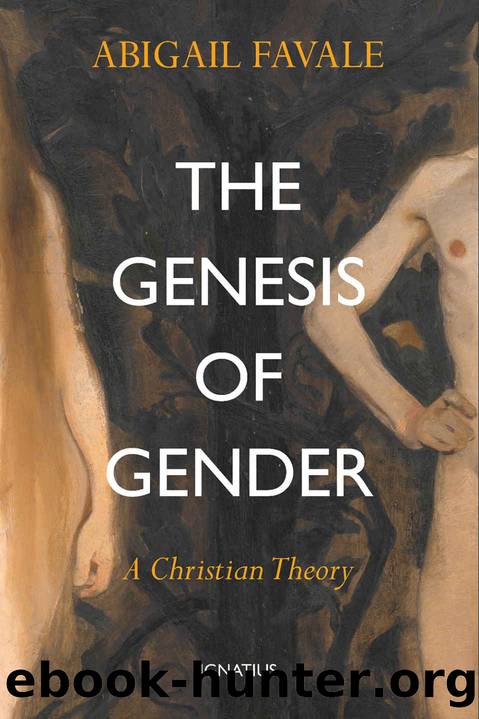The Genesis of Gender: A Christian Theory by Favale Abigail

Author:Favale, Abigail [Favale, Abigail]
Language: eng
Format: epub
ISBN: 9781642292176
Publisher: Ignatius Press
Published: 2022-07-21T00:00:00+00:00
Body as Sacrament
Iâve been spending a fair bit of time here on the biological plane. Itâs important to understand what sex is, and how sexual development unfolds, in order to be able to counter the postmodern myths. That canât be the extent of our discussion, however, if weâre thinking from a Christian perspective. Our consideration of sex and gender must be attuned to the holistic and sacred reality of the person âthe person as an integrated unity of body and soul. We must follow a path of contemplation that sees the various dimensions of personhood in order to receive the miracle of each person. This is a path that moves toward integration, from disorder to wholeness. The postmodern approach to sex and gender runs in the opposite direction, into fragmentation, a piecemeal self, where body and psyche and desire are split off from one another and rearrangeableâwhere the body is not the foundation of personal identity, but rather its lifeless tool.
In contrast, the personalist approach allows us to see each human being as a person , rather than a collection of ever-proliferating labels, and, more importantly, to attune our awareness to the sacramentality of every human body. Bodies are not âjustâ bodies. Bodies are persons made manifest. The sacramental principle is always at work: the visible reveals the invisible. The body reveals to us the eternal and divine reality of the personâa reality that can only break into the tangible, sensible world through embodiment.
That is how God enters into our world and reveals himself, through the incarnational reality of Christ, who became a body that we might know and love the invisible God. The Incarnation is both a historical moment, a plot on the timeline of the world story, and an eternal moment. The divine Person who quickened in the womb of Mary is also the Person who, in the Eucharist, clothes himself in the molecules of wine and bread, that he might be placed on our tongues and engulfed by our hearts. This mysteryâthe sacramental mystery of the Incarnationâshould frame our vision of all that is.
Too easily, we lose sight of this mystery; we allow our vision to contract, to become superficial and self-serving. We fall into the perennial error of seeing some human bodies as not-quite-human and thus disposable, cast out of the circle of whatâs seen and whatâs valued.
This time-worn tendency is on glaring display in Flannery OâConnorâs story âA Temple of the Holy Ghostâ. Told from the perspective of an imaginative child who fantasizes about heroic martyrdom while skimping on her prayers, this story casts a bright beam on the dignity and sacramentality of the intersex person.
Thereâs a fair in town, one with a Ferris wheel, merry-go-round, and âclosed tentâ exhibits for adults only. The child protagonist hears two older girls talking in hushed tones about what they saw in one of the tents: a âfreakâ that was âa man and woman bothâ. 9 This person had âa particular nameâ, but the girls donât remember it, instead using demeaning terms like âyou-know-whatâ and the excising pronoun âItâ.
Download
This site does not store any files on its server. We only index and link to content provided by other sites. Please contact the content providers to delete copyright contents if any and email us, we'll remove relevant links or contents immediately.
Machine Learning at Scale with H2O by Gregory Keys | David Whiting(4183)
Never by Ken Follett(3793)
Harry Potter and the Goblet Of Fire by J.K. Rowling(3775)
Unfinished: A Memoir by Priyanka Chopra Jonas(3333)
Fairy Tale by Stephen King(3220)
The Man Who Died Twice by Richard Osman(2997)
Will by Will Smith(2793)
Rationality by Steven Pinker(2291)
The Dark Hours by Michael Connelly(2244)
Can't Hurt Me: Master Your Mind and Defy the Odds - Clean Edition by David Goggins(2228)
It Starts With Us (It Ends with Us #2) by Colleen Hoover(2198)
The Storyteller by Dave Grohl(2172)
The Dawn of Everything: A New History of Humanity by David Graeber & David Wengrow(2122)
Friends, Lovers, and the Big Terrible Thing by Matthew Perry(2119)
The Becoming by Nora Roberts(2088)
The Stranger in the Lifeboat by Mitch Albom(2050)
Cloud Cuckoo Land by Anthony Doerr(2035)
Einstein: His Life and Universe by Walter Isaacson(1967)
Love on the Brain by Ali Hazelwood(1965)
